A Comparative Study of Healthcare Systems: US and Germany Models
VerifiedAdded on 2023/06/03
|8
|1755
|99
Report
AI Summary
This report provides a detailed comparison of the healthcare systems in the United States and Germany, focusing on key aspects such as access to healthcare for children, unemployed individuals, and retired people, medication coverage, requirements for specialist referrals, and coverage for preexisting conditions. It highlights the roles of public and private insurance schemes in both countries, including the Affordable Care Act (ACA) in the US and the German health insurance system. The analysis delves into the financial implications of healthcare delivery, noting how income levels and government policies influence access and coverage in both nations. The report concludes that both systems are complex and multifaceted, with ongoing efforts to ensure equitable access and financial protection for their citizens, while also acknowledging the differences in their approaches to public insurance management and regulation of private insurance.
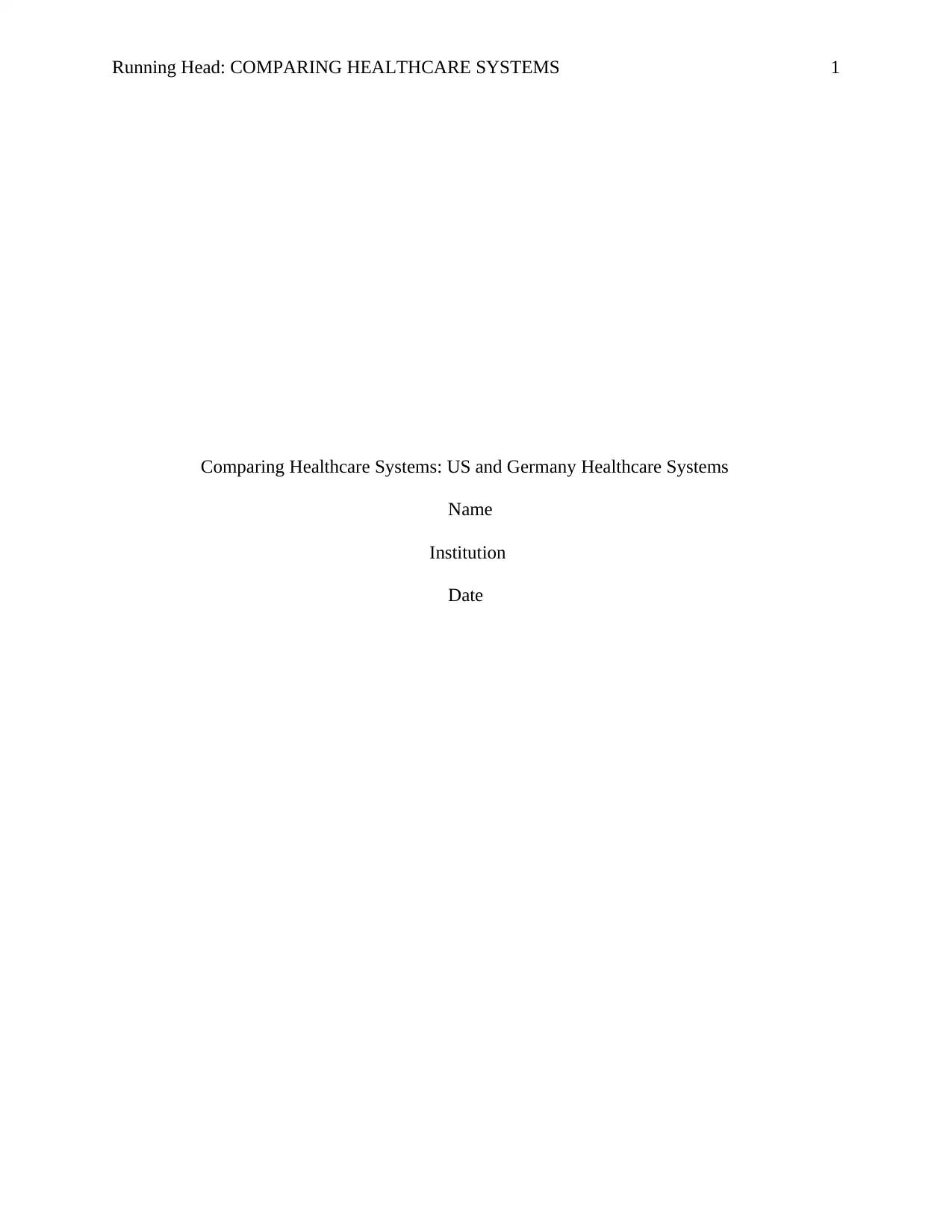
Running Head: COMPARING HEALTHCARE SYSTEMS 1
Comparing Healthcare Systems: US and Germany Healthcare Systems
Name
Institution
Date
Comparing Healthcare Systems: US and Germany Healthcare Systems
Name
Institution
Date
Paraphrase This Document
Need a fresh take? Get an instant paraphrase of this document with our AI Paraphraser
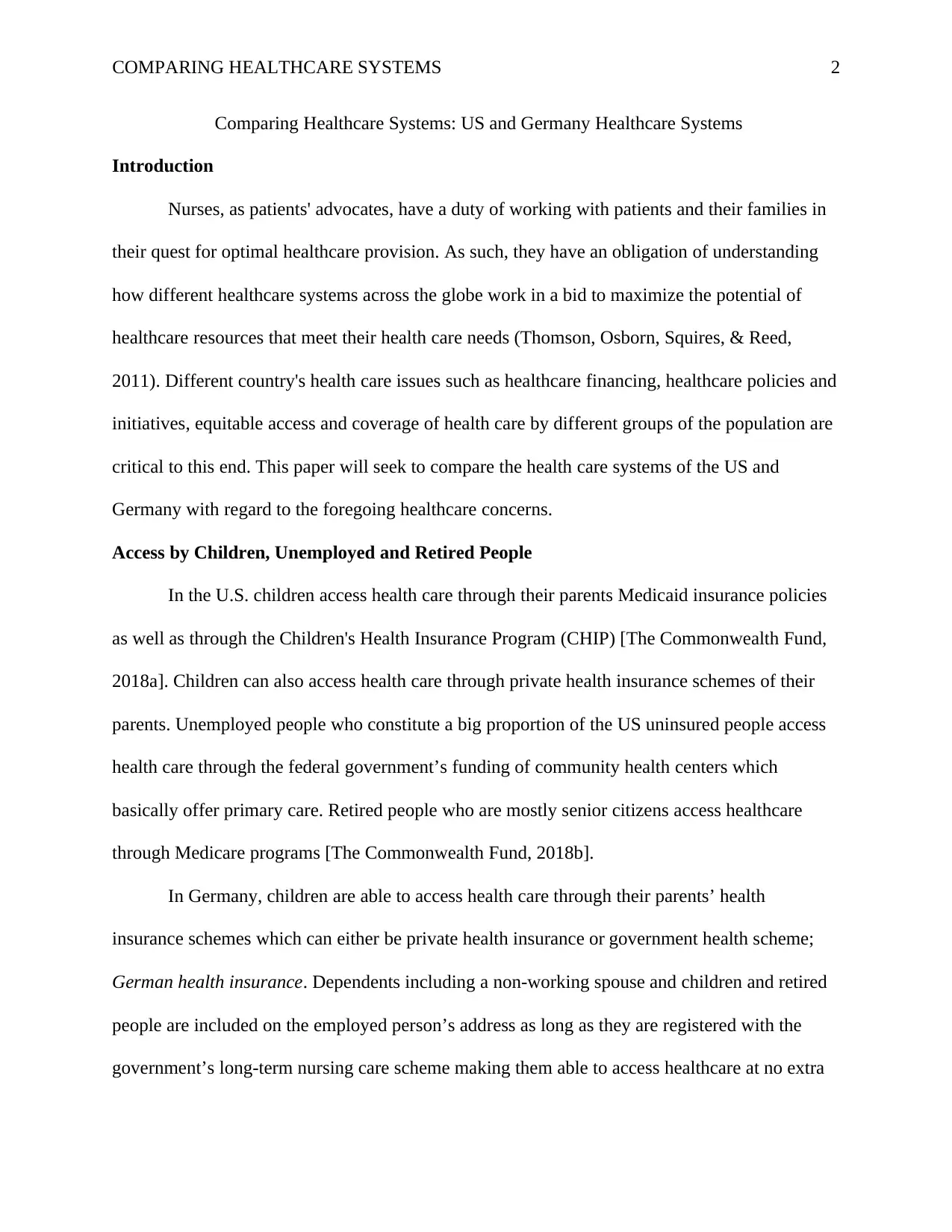
COMPARING HEALTHCARE SYSTEMS 2
Comparing Healthcare Systems: US and Germany Healthcare Systems
Introduction
Nurses, as patients' advocates, have a duty of working with patients and their families in
their quest for optimal healthcare provision. As such, they have an obligation of understanding
how different healthcare systems across the globe work in a bid to maximize the potential of
healthcare resources that meet their health care needs (Thomson, Osborn, Squires, & Reed,
2011). Different country's health care issues such as healthcare financing, healthcare policies and
initiatives, equitable access and coverage of health care by different groups of the population are
critical to this end. This paper will seek to compare the health care systems of the US and
Germany with regard to the foregoing healthcare concerns.
Access by Children, Unemployed and Retired People
In the U.S. children access health care through their parents Medicaid insurance policies
as well as through the Children's Health Insurance Program (CHIP) [The Commonwealth Fund,
2018a]. Children can also access health care through private health insurance schemes of their
parents. Unemployed people who constitute a big proportion of the US uninsured people access
health care through the federal government’s funding of community health centers which
basically offer primary care. Retired people who are mostly senior citizens access healthcare
through Medicare programs [The Commonwealth Fund, 2018b].
In Germany, children are able to access health care through their parents’ health
insurance schemes which can either be private health insurance or government health scheme;
German health insurance. Dependents including a non-working spouse and children and retired
people are included on the employed person’s address as long as they are registered with the
government’s long-term nursing care scheme making them able to access healthcare at no extra
Comparing Healthcare Systems: US and Germany Healthcare Systems
Introduction
Nurses, as patients' advocates, have a duty of working with patients and their families in
their quest for optimal healthcare provision. As such, they have an obligation of understanding
how different healthcare systems across the globe work in a bid to maximize the potential of
healthcare resources that meet their health care needs (Thomson, Osborn, Squires, & Reed,
2011). Different country's health care issues such as healthcare financing, healthcare policies and
initiatives, equitable access and coverage of health care by different groups of the population are
critical to this end. This paper will seek to compare the health care systems of the US and
Germany with regard to the foregoing healthcare concerns.
Access by Children, Unemployed and Retired People
In the U.S. children access health care through their parents Medicaid insurance policies
as well as through the Children's Health Insurance Program (CHIP) [The Commonwealth Fund,
2018a]. Children can also access health care through private health insurance schemes of their
parents. Unemployed people who constitute a big proportion of the US uninsured people access
health care through the federal government’s funding of community health centers which
basically offer primary care. Retired people who are mostly senior citizens access healthcare
through Medicare programs [The Commonwealth Fund, 2018b].
In Germany, children are able to access health care through their parents’ health
insurance schemes which can either be private health insurance or government health scheme;
German health insurance. Dependents including a non-working spouse and children and retired
people are included on the employed person’s address as long as they are registered with the
government’s long-term nursing care scheme making them able to access healthcare at no extra
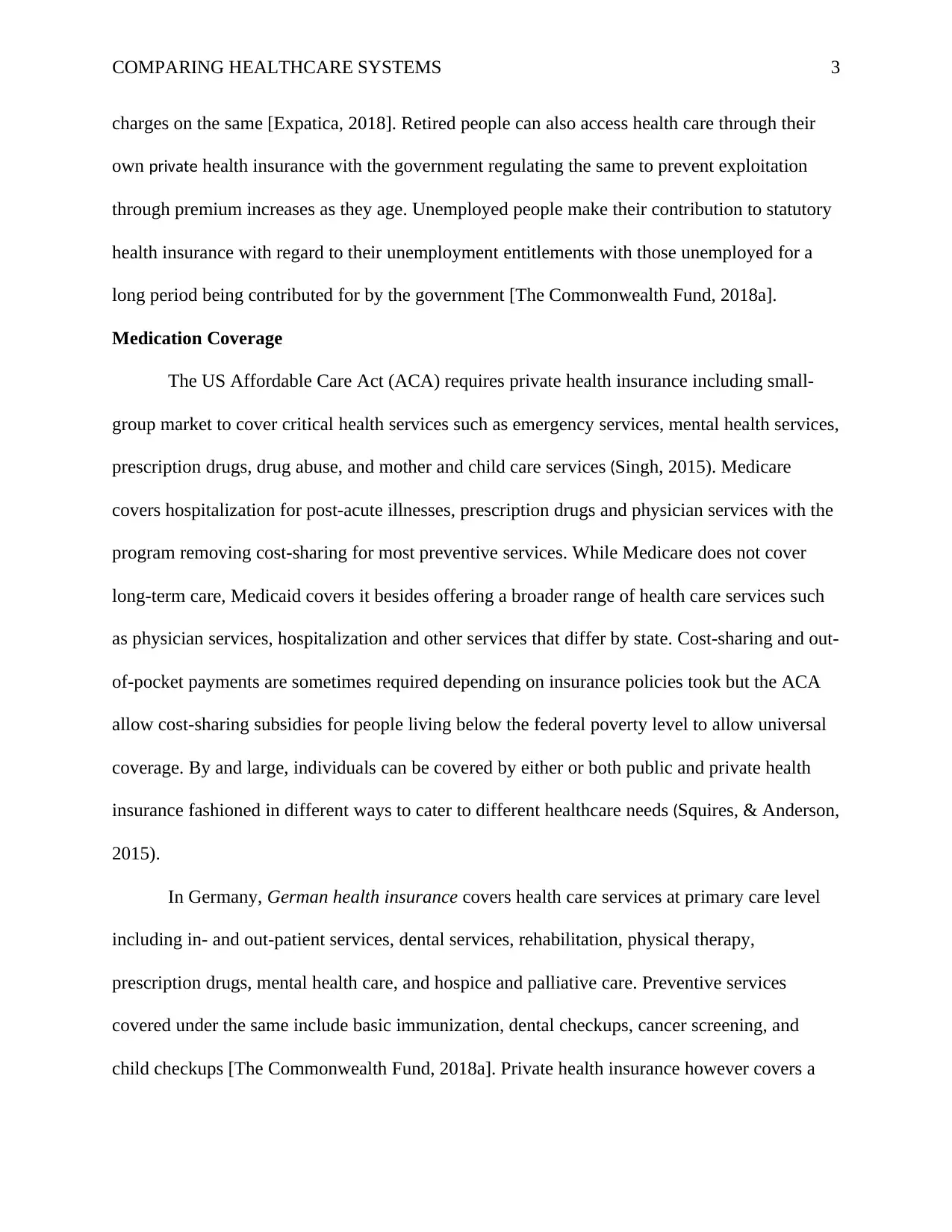
COMPARING HEALTHCARE SYSTEMS 3
charges on the same [Expatica, 2018]. Retired people can also access health care through their
own private health insurance with the government regulating the same to prevent exploitation
through premium increases as they age. Unemployed people make their contribution to statutory
health insurance with regard to their unemployment entitlements with those unemployed for a
long period being contributed for by the government [The Commonwealth Fund, 2018a].
Medication Coverage
The US Affordable Care Act (ACA) requires private health insurance including small-
group market to cover critical health services such as emergency services, mental health services,
prescription drugs, drug abuse, and mother and child care services (Singh, 2015). Medicare
covers hospitalization for post-acute illnesses, prescription drugs and physician services with the
program removing cost-sharing for most preventive services. While Medicare does not cover
long-term care, Medicaid covers it besides offering a broader range of health care services such
as physician services, hospitalization and other services that differ by state. Cost-sharing and out-
of-pocket payments are sometimes required depending on insurance policies took but the ACA
allow cost-sharing subsidies for people living below the federal poverty level to allow universal
coverage. By and large, individuals can be covered by either or both public and private health
insurance fashioned in different ways to cater to different healthcare needs (Squires, & Anderson,
2015).
In Germany, German health insurance covers health care services at primary care level
including in- and out-patient services, dental services, rehabilitation, physical therapy,
prescription drugs, mental health care, and hospice and palliative care. Preventive services
covered under the same include basic immunization, dental checkups, cancer screening, and
child checkups [The Commonwealth Fund, 2018a]. Private health insurance however covers a
charges on the same [Expatica, 2018]. Retired people can also access health care through their
own private health insurance with the government regulating the same to prevent exploitation
through premium increases as they age. Unemployed people make their contribution to statutory
health insurance with regard to their unemployment entitlements with those unemployed for a
long period being contributed for by the government [The Commonwealth Fund, 2018a].
Medication Coverage
The US Affordable Care Act (ACA) requires private health insurance including small-
group market to cover critical health services such as emergency services, mental health services,
prescription drugs, drug abuse, and mother and child care services (Singh, 2015). Medicare
covers hospitalization for post-acute illnesses, prescription drugs and physician services with the
program removing cost-sharing for most preventive services. While Medicare does not cover
long-term care, Medicaid covers it besides offering a broader range of health care services such
as physician services, hospitalization and other services that differ by state. Cost-sharing and out-
of-pocket payments are sometimes required depending on insurance policies took but the ACA
allow cost-sharing subsidies for people living below the federal poverty level to allow universal
coverage. By and large, individuals can be covered by either or both public and private health
insurance fashioned in different ways to cater to different healthcare needs (Squires, & Anderson,
2015).
In Germany, German health insurance covers health care services at primary care level
including in- and out-patient services, dental services, rehabilitation, physical therapy,
prescription drugs, mental health care, and hospice and palliative care. Preventive services
covered under the same include basic immunization, dental checkups, cancer screening, and
child checkups [The Commonwealth Fund, 2018a]. Private health insurance however covers a
⊘ This is a preview!⊘
Do you want full access?
Subscribe today to unlock all pages.

Trusted by 1+ million students worldwide
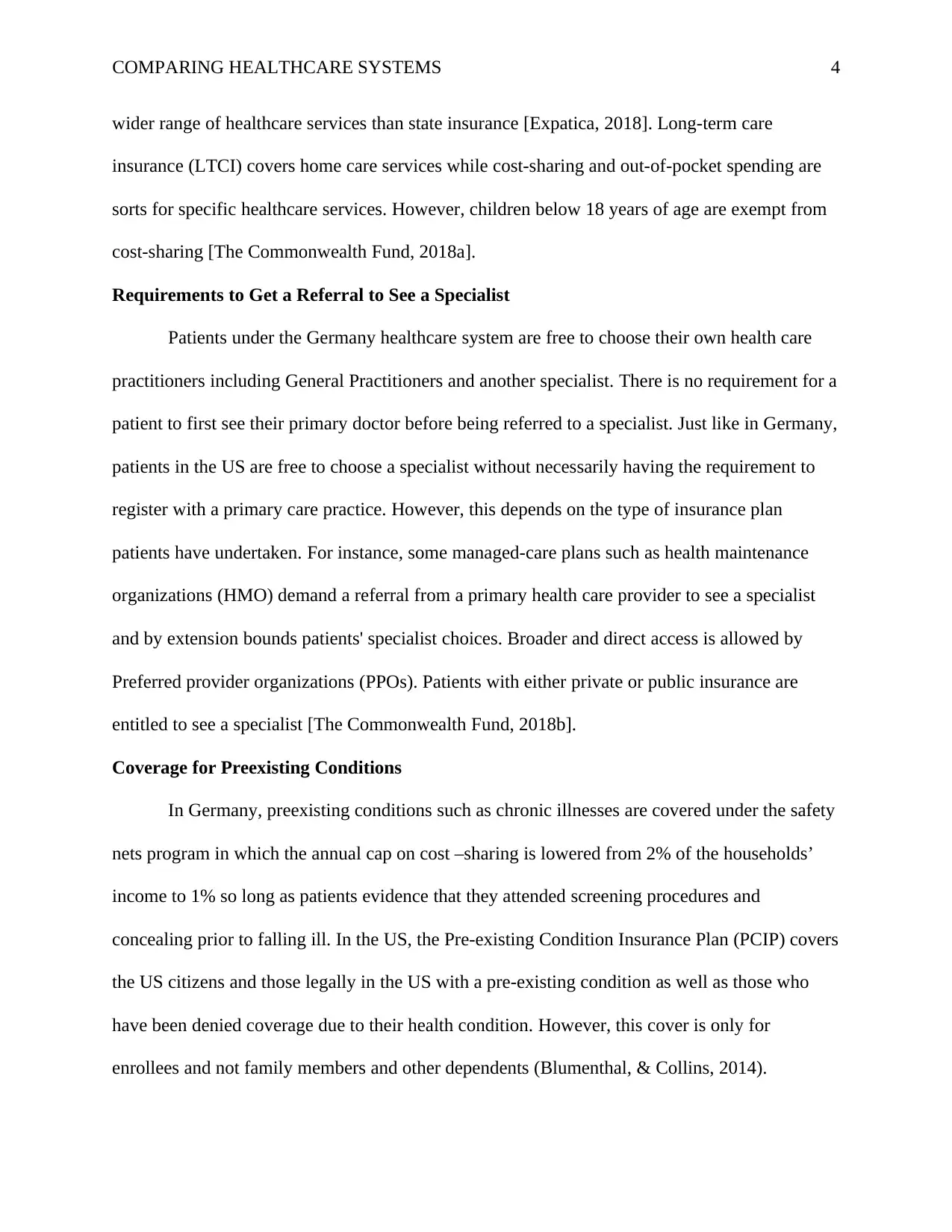
COMPARING HEALTHCARE SYSTEMS 4
wider range of healthcare services than state insurance [Expatica, 2018]. Long-term care
insurance (LTCI) covers home care services while cost-sharing and out-of-pocket spending are
sorts for specific healthcare services. However, children below 18 years of age are exempt from
cost-sharing [The Commonwealth Fund, 2018a].
Requirements to Get a Referral to See a Specialist
Patients under the Germany healthcare system are free to choose their own health care
practitioners including General Practitioners and another specialist. There is no requirement for a
patient to first see their primary doctor before being referred to a specialist. Just like in Germany,
patients in the US are free to choose a specialist without necessarily having the requirement to
register with a primary care practice. However, this depends on the type of insurance plan
patients have undertaken. For instance, some managed-care plans such as health maintenance
organizations (HMO) demand a referral from a primary health care provider to see a specialist
and by extension bounds patients' specialist choices. Broader and direct access is allowed by
Preferred provider organizations (PPOs). Patients with either private or public insurance are
entitled to see a specialist [The Commonwealth Fund, 2018b].
Coverage for Preexisting Conditions
In Germany, preexisting conditions such as chronic illnesses are covered under the safety
nets program in which the annual cap on cost –sharing is lowered from 2% of the households’
income to 1% so long as patients evidence that they attended screening procedures and
concealing prior to falling ill. In the US, the Pre-existing Condition Insurance Plan (PCIP) covers
the US citizens and those legally in the US with a pre-existing condition as well as those who
have been denied coverage due to their health condition. However, this cover is only for
enrollees and not family members and other dependents (Blumenthal, & Collins, 2014).
wider range of healthcare services than state insurance [Expatica, 2018]. Long-term care
insurance (LTCI) covers home care services while cost-sharing and out-of-pocket spending are
sorts for specific healthcare services. However, children below 18 years of age are exempt from
cost-sharing [The Commonwealth Fund, 2018a].
Requirements to Get a Referral to See a Specialist
Patients under the Germany healthcare system are free to choose their own health care
practitioners including General Practitioners and another specialist. There is no requirement for a
patient to first see their primary doctor before being referred to a specialist. Just like in Germany,
patients in the US are free to choose a specialist without necessarily having the requirement to
register with a primary care practice. However, this depends on the type of insurance plan
patients have undertaken. For instance, some managed-care plans such as health maintenance
organizations (HMO) demand a referral from a primary health care provider to see a specialist
and by extension bounds patients' specialist choices. Broader and direct access is allowed by
Preferred provider organizations (PPOs). Patients with either private or public insurance are
entitled to see a specialist [The Commonwealth Fund, 2018b].
Coverage for Preexisting Conditions
In Germany, preexisting conditions such as chronic illnesses are covered under the safety
nets program in which the annual cap on cost –sharing is lowered from 2% of the households’
income to 1% so long as patients evidence that they attended screening procedures and
concealing prior to falling ill. In the US, the Pre-existing Condition Insurance Plan (PCIP) covers
the US citizens and those legally in the US with a pre-existing condition as well as those who
have been denied coverage due to their health condition. However, this cover is only for
enrollees and not family members and other dependents (Blumenthal, & Collins, 2014).
Paraphrase This Document
Need a fresh take? Get an instant paraphrase of this document with our AI Paraphraser
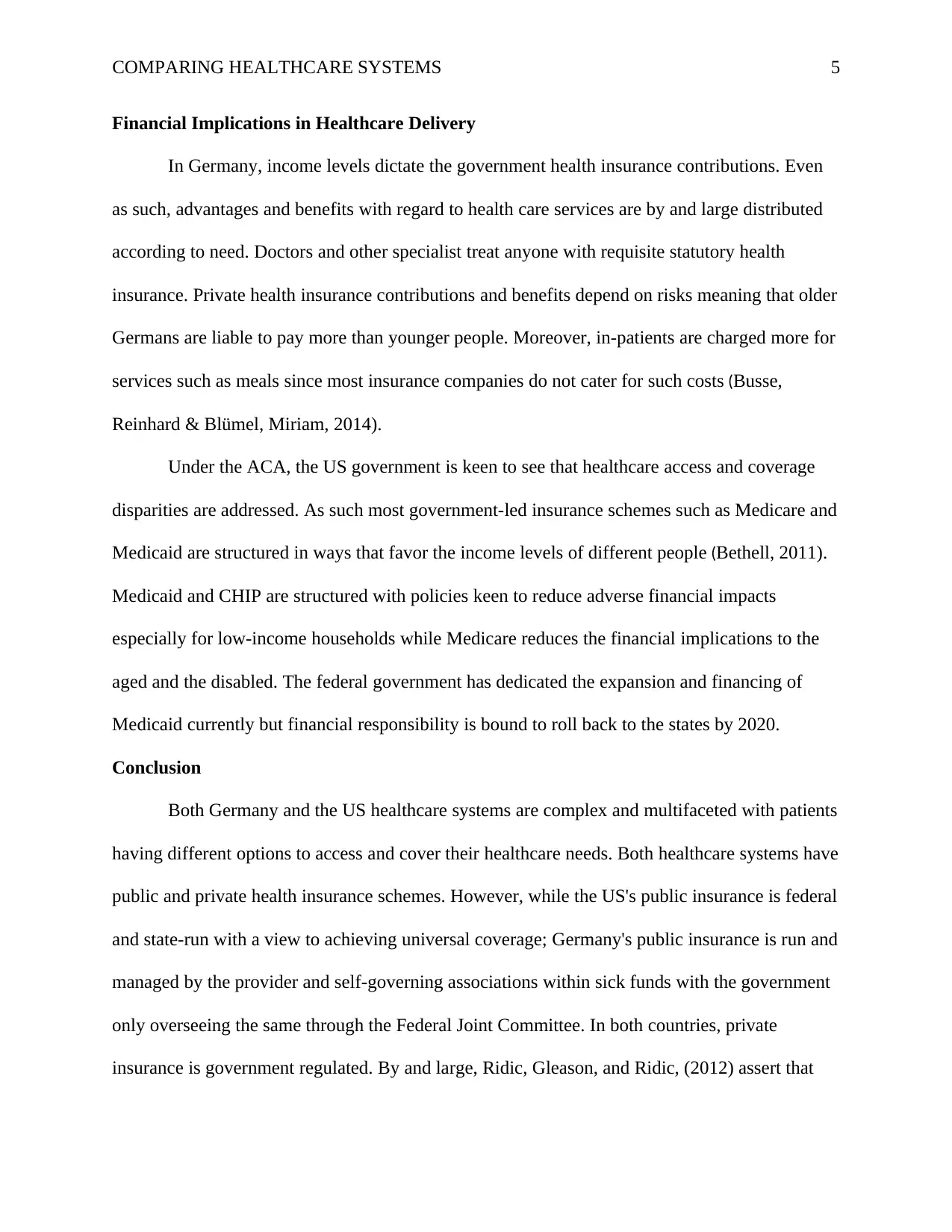
COMPARING HEALTHCARE SYSTEMS 5
Financial Implications in Healthcare Delivery
In Germany, income levels dictate the government health insurance contributions. Even
as such, advantages and benefits with regard to health care services are by and large distributed
according to need. Doctors and other specialist treat anyone with requisite statutory health
insurance. Private health insurance contributions and benefits depend on risks meaning that older
Germans are liable to pay more than younger people. Moreover, in-patients are charged more for
services such as meals since most insurance companies do not cater for such costs (Busse,
Reinhard & Blümel, Miriam, 2014).
Under the ACA, the US government is keen to see that healthcare access and coverage
disparities are addressed. As such most government-led insurance schemes such as Medicare and
Medicaid are structured in ways that favor the income levels of different people (Bethell, 2011).
Medicaid and CHIP are structured with policies keen to reduce adverse financial impacts
especially for low-income households while Medicare reduces the financial implications to the
aged and the disabled. The federal government has dedicated the expansion and financing of
Medicaid currently but financial responsibility is bound to roll back to the states by 2020.
Conclusion
Both Germany and the US healthcare systems are complex and multifaceted with patients
having different options to access and cover their healthcare needs. Both healthcare systems have
public and private health insurance schemes. However, while the US's public insurance is federal
and state-run with a view to achieving universal coverage; Germany's public insurance is run and
managed by the provider and self-governing associations within sick funds with the government
only overseeing the same through the Federal Joint Committee. In both countries, private
insurance is government regulated. By and large, Ridic, Gleason, and Ridic, (2012) assert that
Financial Implications in Healthcare Delivery
In Germany, income levels dictate the government health insurance contributions. Even
as such, advantages and benefits with regard to health care services are by and large distributed
according to need. Doctors and other specialist treat anyone with requisite statutory health
insurance. Private health insurance contributions and benefits depend on risks meaning that older
Germans are liable to pay more than younger people. Moreover, in-patients are charged more for
services such as meals since most insurance companies do not cater for such costs (Busse,
Reinhard & Blümel, Miriam, 2014).
Under the ACA, the US government is keen to see that healthcare access and coverage
disparities are addressed. As such most government-led insurance schemes such as Medicare and
Medicaid are structured in ways that favor the income levels of different people (Bethell, 2011).
Medicaid and CHIP are structured with policies keen to reduce adverse financial impacts
especially for low-income households while Medicare reduces the financial implications to the
aged and the disabled. The federal government has dedicated the expansion and financing of
Medicaid currently but financial responsibility is bound to roll back to the states by 2020.
Conclusion
Both Germany and the US healthcare systems are complex and multifaceted with patients
having different options to access and cover their healthcare needs. Both healthcare systems have
public and private health insurance schemes. However, while the US's public insurance is federal
and state-run with a view to achieving universal coverage; Germany's public insurance is run and
managed by the provider and self-governing associations within sick funds with the government
only overseeing the same through the Federal Joint Committee. In both countries, private
insurance is government regulated. By and large, Ridic, Gleason, and Ridic, (2012) assert that
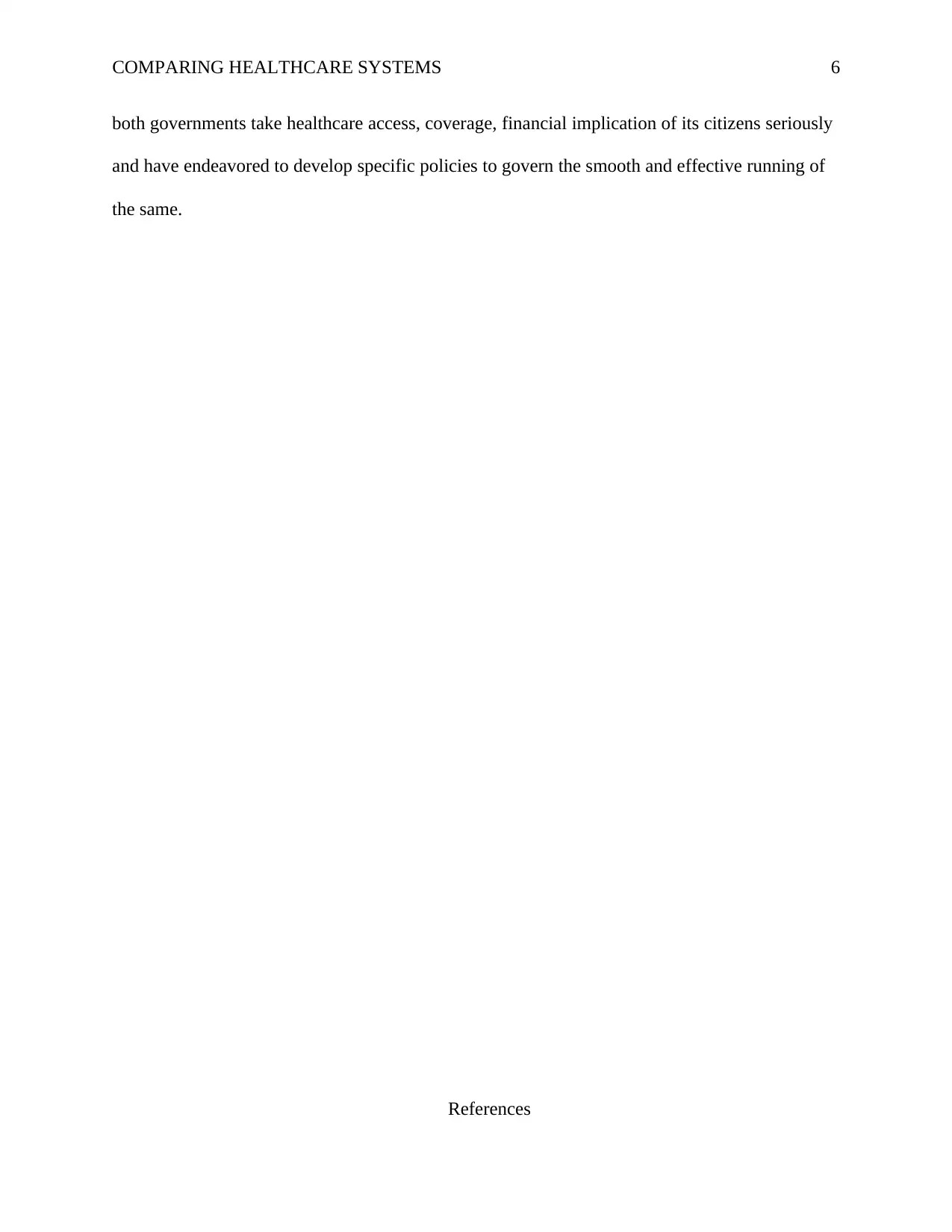
COMPARING HEALTHCARE SYSTEMS 6
both governments take healthcare access, coverage, financial implication of its citizens seriously
and have endeavored to develop specific policies to govern the smooth and effective running of
the same.
References
both governments take healthcare access, coverage, financial implication of its citizens seriously
and have endeavored to develop specific policies to govern the smooth and effective running of
the same.
References
⊘ This is a preview!⊘
Do you want full access?
Subscribe today to unlock all pages.

Trusted by 1+ million students worldwide
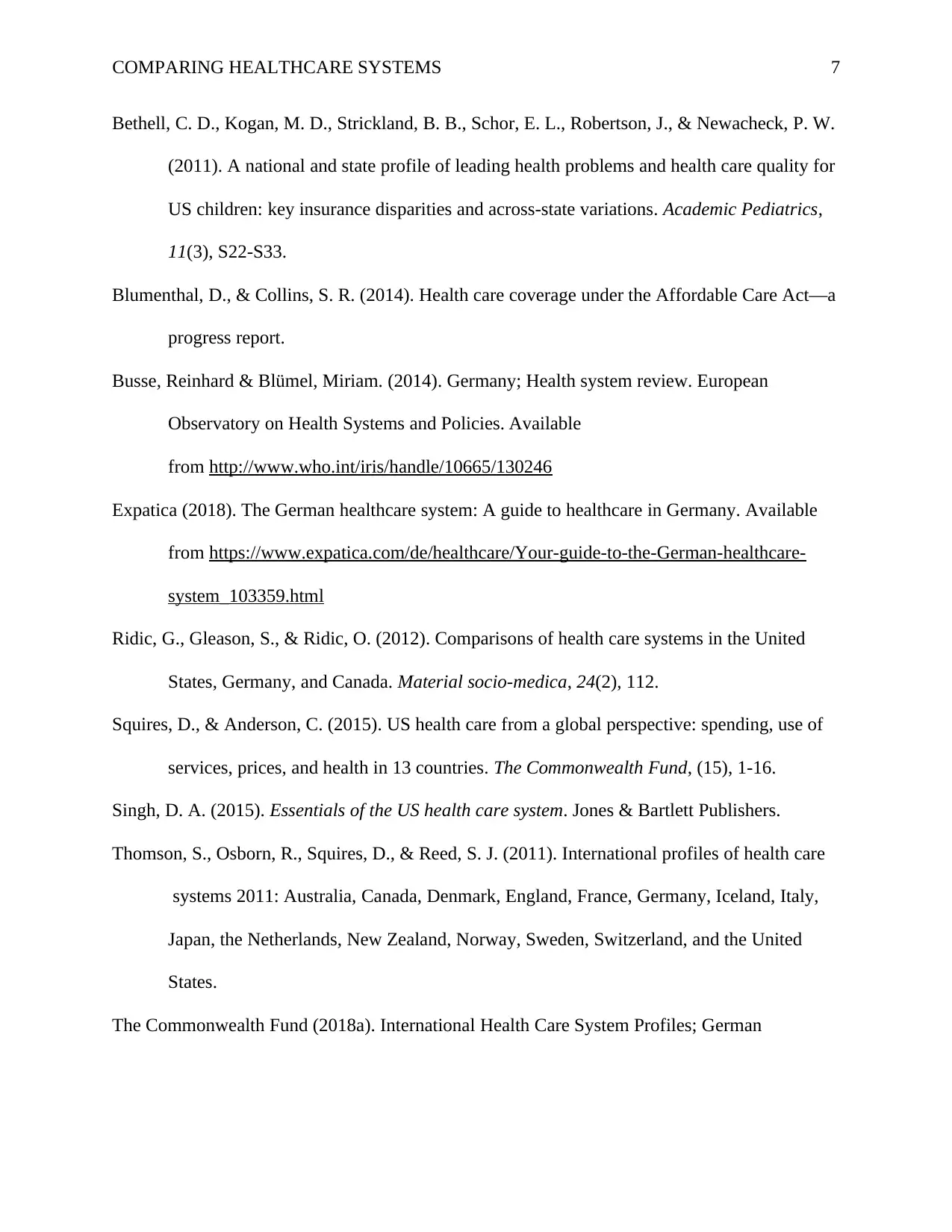
COMPARING HEALTHCARE SYSTEMS 7
Bethell, C. D., Kogan, M. D., Strickland, B. B., Schor, E. L., Robertson, J., & Newacheck, P. W.
(2011). A national and state profile of leading health problems and health care quality for
US children: key insurance disparities and across-state variations. Academic Pediatrics,
11(3), S22-S33.
Blumenthal, D., & Collins, S. R. (2014). Health care coverage under the Affordable Care Act—a
progress report.
Busse, Reinhard & Blümel, Miriam. (2014). Germany; Health system review. European
Observatory on Health Systems and Policies. Available
from http://www.who.int/iris/handle/10665/130246
Expatica (2018). The German healthcare system: A guide to healthcare in Germany. Available
from https://www.expatica.com/de/healthcare/Your-guide-to-the-German-healthcare-
system_103359.html
Ridic, G., Gleason, S., & Ridic, O. (2012). Comparisons of health care systems in the United
States, Germany, and Canada. Material socio-medica, 24(2), 112.
Squires, D., & Anderson, C. (2015). US health care from a global perspective: spending, use of
services, prices, and health in 13 countries. The Commonwealth Fund, (15), 1-16.
Singh, D. A. (2015). Essentials of the US health care system. Jones & Bartlett Publishers.
Thomson, S., Osborn, R., Squires, D., & Reed, S. J. (2011). International profiles of health care
systems 2011: Australia, Canada, Denmark, England, France, Germany, Iceland, Italy,
Japan, the Netherlands, New Zealand, Norway, Sweden, Switzerland, and the United
States.
The Commonwealth Fund (2018a). International Health Care System Profiles; German
Bethell, C. D., Kogan, M. D., Strickland, B. B., Schor, E. L., Robertson, J., & Newacheck, P. W.
(2011). A national and state profile of leading health problems and health care quality for
US children: key insurance disparities and across-state variations. Academic Pediatrics,
11(3), S22-S33.
Blumenthal, D., & Collins, S. R. (2014). Health care coverage under the Affordable Care Act—a
progress report.
Busse, Reinhard & Blümel, Miriam. (2014). Germany; Health system review. European
Observatory on Health Systems and Policies. Available
from http://www.who.int/iris/handle/10665/130246
Expatica (2018). The German healthcare system: A guide to healthcare in Germany. Available
from https://www.expatica.com/de/healthcare/Your-guide-to-the-German-healthcare-
system_103359.html
Ridic, G., Gleason, S., & Ridic, O. (2012). Comparisons of health care systems in the United
States, Germany, and Canada. Material socio-medica, 24(2), 112.
Squires, D., & Anderson, C. (2015). US health care from a global perspective: spending, use of
services, prices, and health in 13 countries. The Commonwealth Fund, (15), 1-16.
Singh, D. A. (2015). Essentials of the US health care system. Jones & Bartlett Publishers.
Thomson, S., Osborn, R., Squires, D., & Reed, S. J. (2011). International profiles of health care
systems 2011: Australia, Canada, Denmark, England, France, Germany, Iceland, Italy,
Japan, the Netherlands, New Zealand, Norway, Sweden, Switzerland, and the United
States.
The Commonwealth Fund (2018a). International Health Care System Profiles; German
Paraphrase This Document
Need a fresh take? Get an instant paraphrase of this document with our AI Paraphraser
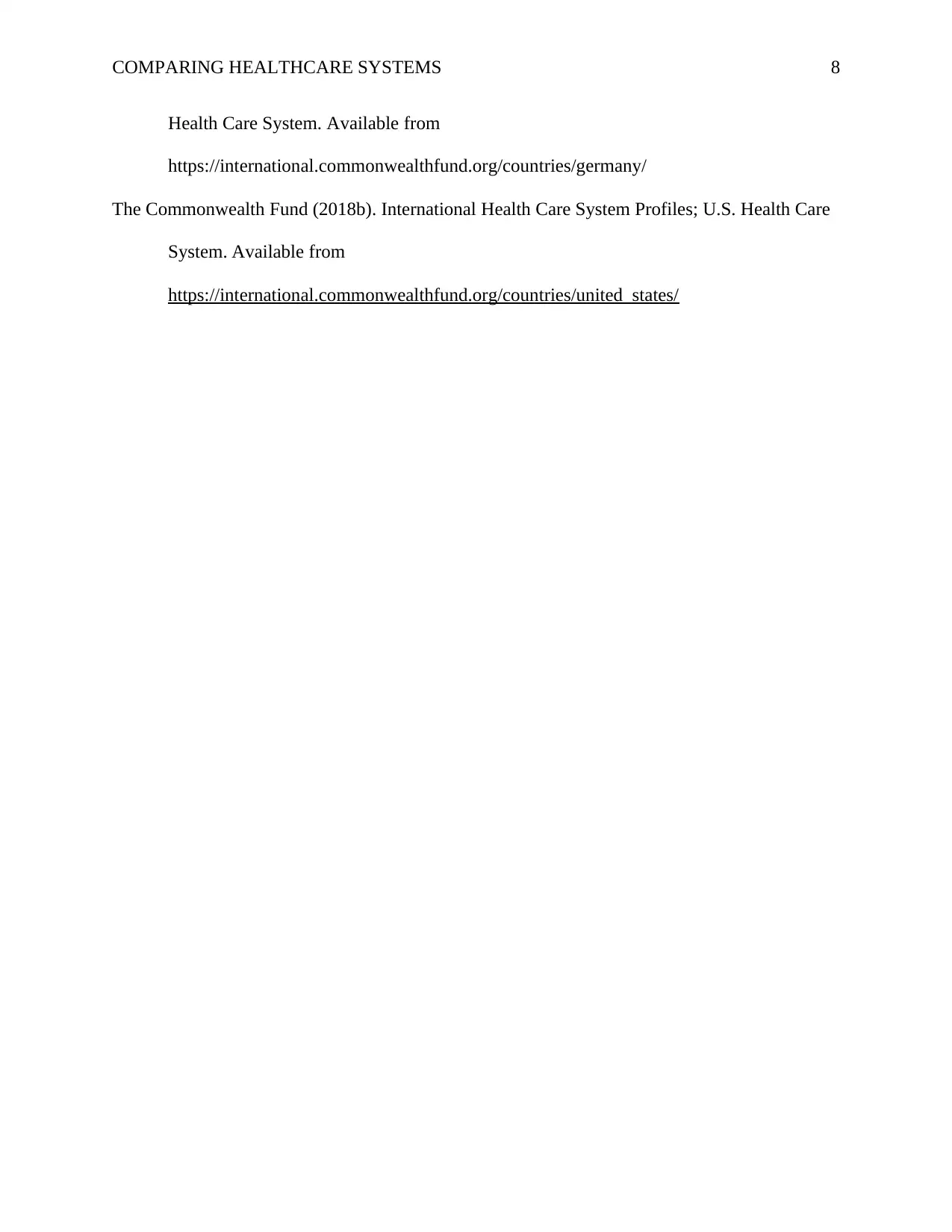
COMPARING HEALTHCARE SYSTEMS 8
Health Care System. Available from
https://international.commonwealthfund.org/countries/germany/
The Commonwealth Fund (2018b). International Health Care System Profiles; U.S. Health Care
System. Available from
https://international.commonwealthfund.org/countries/united_states/
Health Care System. Available from
https://international.commonwealthfund.org/countries/germany/
The Commonwealth Fund (2018b). International Health Care System Profiles; U.S. Health Care
System. Available from
https://international.commonwealthfund.org/countries/united_states/
1 out of 8
Related Documents
Your All-in-One AI-Powered Toolkit for Academic Success.
+13062052269
info@desklib.com
Available 24*7 on WhatsApp / Email
![[object Object]](/_next/static/media/star-bottom.7253800d.svg)
Unlock your academic potential
Copyright © 2020–2025 A2Z Services. All Rights Reserved. Developed and managed by ZUCOL.




